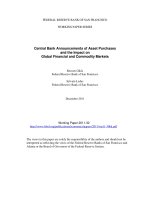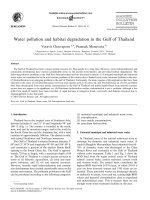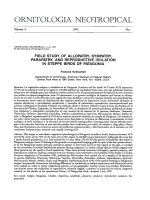Global Firms and Emerging Markets in an Age of Anxiety ppt
Bạn đang xem bản rút gọn của tài liệu. Xem và tải ngay bản đầy đủ của tài liệu tại đây (2.5 MB, 334 trang )
Global Firms and
Emerging Markets in an
Age of Anxiety
S. Benjamin Prasad
Pervez N. Ghauri
Editors
PRAEGER
Global Firms and Emerging
Markets in an Age of AnxietyGlobal Firms and
Emerging Markets in an
Age of Anxiety
Edited by S. Benjamin Prasad and
Pervez N. Ghauri
Library of Congress Cataloging-in-Publication Data
Global firms and emerging markets in an age of anxiety / edited by S. Benjamin Prasad
and Pervez N. Ghauri.
p. cm.
Includes bibliographical references and index.
ISBN 1–56720–421–X (alk. paper)
1. International business enterprises—Management. 2. International business
enterprises—Cross-cultural studies. 3. Globalization. I. Prasad, Benjamin S., 1929– II.
Ghauri, Pervez N., 1948–
HD62.4.G5435 2004
338.8Ј8—dc22 2003062256
British Library Cataloguing in Publication Data is available.
Copyright ᭧ 2004 by S. Benjamin Prasad and Pervez N. Ghauri
All rights reserved. No portion of this book may be
reproduced, by any process or technique, without the
express written consent of the publisher.
Library of Congress Catalog Card Number: 2003062256
ISBN: 1–56720–421–X
First published in 2004
Praeger Publishers, 88 Post Road West, Westport, CT 06881
An imprint of Greenwood Publishing Group, Inc.
www.praeger.com
Printed in the United States of America
The paper used in this book complies with the
Permanent Paper Standard issued by the National
Information Standards Organization (Z39.48–1984).
10987654321
Contents
Illustrations vii
Preface xi
Part I Emerging Challenges 1
Chapter 1 On Multinationals after 1989 3
S. Benjamin Prasad
Chapter 2 The Bald Eagle Cannot Find Its Way in the Rain
Forest 13
Alvaro Cuervo-Cazurra and C. Annique Un
Chapter 3 Challenges for the European Auto Multinationals 37
Heike Proff
Chapter 4 Multinationals and Technology Development in Latin
America and East Asia 61
Andre´s Lo´pez and Marcela Miozzo
Chapter 5 Supranational Rules on Strategy Context: Embraer
and Brazil’s Aerospace Program 83
Thomas C. Lawton and Steven M. McGuire
Part II Changing Contexts 103
Chapter 6 Initial Trust of Joint Venture Partners in Emerging
Nations 105
Kwong Chan, W. Harvey Hegarty, and Stewart R. Miller
vi Contents
Chapter 7 Family Conglomerates: Key Features Relevant to
Multinationals 121
Destan Kandemir, Daekwan Kim, and S. Tamer Cavusgil
Chapter 8 International Joint Venture Control: An Integrated
Framework 147
Yan Zhang and Haiyang Li
Chapter 9 An Analysis of Joint Venture Activities in Southeast
Asia 171
Daniel C. Indro and Malika Richards
Chapter 10 National Culture in China and Multinationals’
Performance 195
Ji Li
Chapter 11 Entering Emerging Markets: Ignorance and
Discovery 207
Jan Johanson and Martin Johanson
Part III Prospects for Global Firms 225
Chapter 12 Strategies of Multinationals in Contemporary China 227
Peter Enderwick
Chapter 13 Rethinking MNE-Emerging Market Relationships:
Some Insights from East Asia 251
Mo Yamin and Pervez N. Ghauri
Chapter 14 Institutions and Market Reforms: A Logical Guide
for MNE Investments 267
Ram Mudambi and Pietro Navarra
Chapter 15 On Economic Liberalization in India 285
Rose M. Prasad
Part IV Looking toward 2010 305
Chapter 16 A Look Ahead: Multinational Enterprises and
Emerging Markets 307
Pervez N. Ghauri
Selected Bibliography 311
Index 313
About the Editors and Contributors 317
Illustrations
Tables
0.1 Twenty-Four Books on Multinationals Identified as Unique
Structural Forms of Organization 1964–1986 xii
2.1 Summary of Arguments: Difficulties in the
Internationalization of DCMNEs in the LDCs 19
4.1 FDI Inflows by Area and Period, 1970–1999 63
4.2 Ratio of FDI Inflows to Gross Fixed Capital Formation for
Different Periods, 1971–1998 66
4.3 Share of FDI Inflows in Manufactured Exports and Output 72
5.1 A Comparison of Models 90
7.1 Demographic Profiles of the Family Conglomeration 123
8.1 A Summary of Major Characteristics of the Cases 154
8.2 The Patterns of Task Interdependence, Resource
Contributions, and Control 160
8.3 The Dynamic Relationships between IJV Control and
Performance 163
9.1 Southeast Asian Joint Venture Sample Description 176
viii Illustrations
9.2 Descriptive Statistics and Correlations between Independent
Variables 178
9.3 Results of Multinomial Logistic Regressions Examining the
Determinants of ASEAN Joint Venture Activities 186
9.4 Summary of Results 187
10.1 Descriptive Statistics 201
10.2 Effect of Home Country Culture on MNEs’ Behavior in
China 202
10.3 Effect of Home Country Culture on MNEs’ Performance in
China 203
11.1 The Firms and Types of Activity and Discovery 220
12.1 Internal Changes and Their Implications for Business
Strategy 235
13.1 East Asian Policies toward Multinational Companies 255
13.2 The Dominance of Pro-FDI Policies in Emerging and
Developing Countries, 1991–2000 256
13.3 Share of LDCs in FDI Stocks, FDI Flow, and Number of
Affiliates in 1999 257
13.4 Reinvigorating Functions of State 261
14.1 Summary Statistics 273
14.2 Estimating the Level of Reform in 1995: Heteroskedasticity-
corrected OLS Estimates 274
14.3 Estimating the Change in the Level of Reform 1990–1995:
Heteroskedasticity-corrected OLS Estimates 277
15.1 Fraser Index (1976–1995) for Selected Six Countries 290
15.2 Foreign Exchange Reserves and Liberalization in 11
Emerging Nations 292
Figures
1.1 Theoretical Streams Leading to MNE (Multinational
Enterprise) Paradigms and International Corporate
Management 8
2.1 Difficulties in the Internationalization of MNEs in the
LDCs: A Research Framework 17
Illustrations ix
3.1 Projected Capacity Utilization in the Automotive Industry
Classified According to Region and European Manufacturers 39
3.2 Export Intensity and Foreign Direct Investment of German
Enterprises As Well As Falling Price Premiums in Germany 40
3.3 Industrialization As a Means of Economic Development 43
3.4 Current and Targeted Linkages in the Automotive Industry
under the Malaysian “Cluster Approach” 44
3.5 Industrial Clustering and the Need for Large-Scale
Production Capacities 46
3.6 Necesssary Extension of the Theory of Foreign Direct
Investment to Include Interactions between Markets to Take
into Account Overcapacity and Export Competition 51
3.7 Approaches for Reducing the Negative External Effects of
Overcapacity and Export Competition 53
3.8 Possible Responses of the European Automotive Industry to
Overcapacities and Export Competition 54
6.1 A Conceptual Framework of Initial Trust of Joint Venture
Partners in Emerging Nations 108
7.1 Drivers of Family Conglomerate’s Evolution 129
7.2 Internationalization of Family Conglomerates 134
7.3 Appropriate Market Entry Strategies for Western
Companies in Emerging Markets 139
8.1 An Integrated Framework of IJV Control 149
9.1 Description of Southeast Asian Joint Ventures, by Partner
Type 181
9.2 Description of Southeast Asian Joint Ventures, by Country 184
Multinationals, as most people would know, recognize, admire, fear, and criti-
cize, have been variously characterized for more than three decades. In the
1970s, an American, a British, or a European company that had subsidiaries
in two or more countries was called a multinational corporation. In the 1980s,
considering the history of foreign investment, a variety of nonmanufacturing
companies—such as banks, insurance companies, and trading companies—
also came to be recognized as multinational companies. Different authorsused
different terms. For example, Frederick Donner, in 1967, wrote a book on
multinationals with the title Worldwide Industrial Enterprises. Charles Kindle-
berger authored a book, titled The International Corporation (1970); Ananth
Negandhi and S. Benjamin Prasad coauthored a volume called The Frightening
Angels: Multinationals in Developing Countries (1975). The key point here is
that the multinational phenomenon is not a contemporary development. At
present, most companies can be regarded as global firms. During the past 25
years, many developing countries have followed the advice of the International
Monetary Fund (IMF) to privatize, liberalize, and become a participant in the
free-market economy. Many countries have dismantled their public-sector
enterprises, and have opened up their economies to imports of goods, capital,
and technology. As a result, the world is becoming more interconnected than
before World War II, with the level of imports, exports, cross-border invest-
ments, and movement of managers and executives all increasing in noticeable
proportions. In order to capture the essence of what was happening in the
industrial and the service world—in, so to speak, the globalizing economy—
many writers in the United States and the United Kingdom authored scores
of books. A selected listing of 24 vintage books on multinationals can be found
xii Preface
Table 0.1
Twenty-Four Books on Multinationals Identified as Unique Structural Forms
of Organization 1964–1986
*Complete titles can be found in the Selected Bibliography.
in Table 0.1. A complete reference of these books can be found in the
bibliography.
These 24 books, along with other books, articles, and commentaries, not
only described the nature and organization of the multinationals in the post–
World War II era, but they also spoke implicitly of the problems of coordi-
nation, of relationships with host countries, and of the long-run impact of
foreign commercial enterprises forging partnerships and alliances with do-
mestic firms and state enterprises, to name a few.
The multinational corporate phenomenon can be seen either as an ancient
institution (Moore and Lewis 1999) or as a post–World War II development.
That is not to say that there were no multinational enterprises in the eigh-
teenth or the nineteenth century. There were, but they were few in number,
and they were financed not by common citizens, but by either the royalty, the
Preface xiii
literati, or the mercantile bankers. At any rate, one is at liberty to take a
historical perspective of a multinational such as Ford, Nestle, or Unilever, or
alternatively focus on the firms that have metamorphosed into multinationals
in the period of 1975–2000. The perspective is in the beholder’s eye, the
researcher’s interest, or the strategic intent of reading, thinking, and writing.
We have found the historical perspective of multinationals to be a valuable
one.
The current economic perspective of the multinational enterprise, or even
the cross-cultural dimensions of firms, has a legitimate place and the inquiry
is worthy of pursuit. Even though economics-based academic publications and
their editors insist on robust studies of multinational enterprises (MNEs)
grounded in theory, conducting business abroad has almost always remained
more of an art than a science. One important aspect of this art has been
interaction with the host nations and their governmental agencies. This aspect
has taken on added dimensions since the September 11, 2001, tragedy. Sub-
sequent to the tragedy, there have occurred numerous changes in the world
economic, as well as political, arenas. In short, the landscape for the multi-
nationals is, as we see it, completely different. There has been a rapid change
in the relationships between guest firms and host nations, the multinationals
and emerging nations in particular manifesting the dominant theme of anxi-
ety. Multinationals’ environmental uncertainty has gone up; in addition, anxi-
ety levels have elevated. The hosts—emerging markets—are now unsure of
the strategic implications of the decisions of multinationals. Attracting foreign
direct investment (FDI) by means of creating a conducive host-country en-
vironment has been a standard approach for many years beginning in the early
1960s in the Republic of Ireland. We ponder whether that approach is now
sufficient, in the post–9-11 era, to maintain an increasing inflow of precious
capital from abroad.
In order to shed light on many of the underlying issues that have surfaced
since 2001, we invited a cross section of scholars, who had shown a keen
interest in the broad topics of interfirm cooperation, firm-host government
relations, FDI, and the general well-being of relatively poorer nations. In
order to narrow down the host country universe, we selected the emerging
markets—some 25 nation-states. In response, we received 22 papers.
Among the 22 papers, 20 of them went through the blind-review process.
Each was read by Ghauri, Prasad, and at least one external reviewer who had
competence to critique and suggest concrete revisions. Fifteen of the papers
were finally accepted after one or two revisions, and readers will find them as
chapters dealing with a few key dimensions of managing either the internal
efficiency or the external effectiveness of multinationals in the twenty-first
century beset by post–9-11 anxiety. We identify external effectiveness as pos-
sessing the skills of networking, allying, and interfacing with a host of stake-
holders or constituencies.
Many of the authors who contributed to this research compendium will-
xiv Preface
ingly did so, and we were pleased to note that many of their coauthors were
of a younger generation who looked forward to pursuing their professional
interests in the global economy. Others were mature scholars who had lived
through the decades of the dollar devaluation, the preeminence of Japanese
multinationals, the emergence of technology-driven competition, the un-
precedented expansion of information technologies, the Y2K threat, the 9-11
tragedy, and the anxiety of threats and of conflicts.
Three groups of individuals deserve our gratitude and thanks. First and
foremost are the contributors who were patient, responsive to our rewriting
requests, and tolerant of minor criticisms. Some of the contributors, as readers
will recognize, are senior researchers, and some are younger enthusiasts. To
all of the contributors, we extend our heartfelt thanks.
The second group is the two editors at the Greenwood Publishing Group.
We are grateful to both Eric Valentine, until recently editor of Quorum
Books, the imprint that was consolidated with the Praeger Series. Praeger is
now headed by editor Hilary Clagett who, during the past six months, has
made numerous valuable suggestions, and the end result is the current title
of this book: Global Firms and Emerging Markets in the Age of Anxiety. We
believe that, at present, we are all living in an era of anxiety, but we hope the
anxiety shall be ephemeral.
Finally, the third group comprises our faculty associates and the graduate/
undergraduate students who were extremely helpful in the preparation of the
manuscript. We would also like to thank Dr. Rose Prasad of the Finance
Department, Management Departmental secretaries Marsha Dinkfield and
Mary Jones, and student assistants—Amber, Alisha, Avinash, Gopal, Pratik,
Satish—at Central Michigan University. We owe a debt of gratitude to some
of our colleagues at UMIST, United Kingdom, including the staff of the
international business unit and in particular Anna Zuyeva and Gillian
Geraghty. Errors and omissions are those of the authors of the chapters.
February 27, 2003
S. Benjamin Prasad
York Research Center, New Jersey
Pervez N. Ghauri
UMIST, U.K.
P
ART
I
Emerging Challenges
HAPTER
1
On Multinationals after 1989
S. Benjamin Prasad
Since World War II, within the realm of industrial management and econom-
ics, the influence of international events has been significant. If one were to
identify the basic factors leading to industrial development, then management
is clearly an important dimension for economic growth. Management litera-
ture contains definitions of the term, management, as a process, a set of co-
ordinated functions in a firm, a type and level of skill and ability, or a cadre of
people. Most of these definitions are culture-oriented, and they are legiti-
mately so. Yet, one ought not to take the culture route too far, because cultural
explanations will have limits too.
When we, in the United States, consider management and organization,itis
often in terms of the values and ends to which we are accustomed, and also,
as the terms relate to the conduct of business enterprises as we see them in
North America. The American economy has been an archetype of what is
loosely known as the Western world. But since the 1980s, an Eastern influence
has swept in—initially in terms of the soft skills that catapulted Japan to num-
ber one in the world in those skills, and later in the 1990s, in terms of the
enterprise software that has been a boon to American business, to its cost
effectiveness, and to its productivity.
International management is concerned with effectively managing a firm’s
resources abroad. Many multi-disciplinary approaches have been advanced
toward this goal, as can be seen in Figure 1.1 (p. 8). The real challenges to
global firms are in the emerging nations.
The industrial revolution began, not in the United States but in England,
with the seminal observations made by Adam Smith in an English pin factory,
on the beginning and growth of modern industrialism, conceptualizing the
4 Global Firms and Emerging Markets in an Age of Anxiety
merits of specialization in the notion of division of labor. Industrialism, as
most recognize, is a general organization of a society built largely on mech-
anized industry (or tertiary industries) rather than agriculture, craftsmanship,
or commerce. It is different from mercantilism albeit the newly industrialized
states often pursued mercantilist policies.
Commerce, from times immemorial, has been conducted on a small as well
as on a large scale. Moore and Lewis (1999) identify some of the earliest
trading companies and guild-like colonies established by the Phoenician mer-
chants, the princes of their society. However, it is worth noting that in sev-
enteenth century China, the Qing (Ching) dynastic emperors from the north
(that is, the region of Manchuria) did not view the pursuits of the merchants
in the southeast, as an accomplished modus vivendi (Spence 1990). The Brit-
ish rulers also “regarded merchants as a lesser breed in the hierarchy of im-
perial breed” (Keay 1991).
MULTINATIONALS AFTER 1989
Multinationals after 1989—the year in which the Berlin Wall came down—
have undergone a variety of changes and have faced many new challenges.
The best way to capture the essence of these changes is a two dimensional
issue. First and foremost is for academics to learn how multinational firms—
American or other parents—have weathered the storms of change. Some of
the consumer multinationals, armed with global brands and appealing adver-
tising, such as the Coca-Colas and the McDonalds were in the limelight at
one time. Other consumer durable multinationals have either gone under,
restructured, or have emerged as born-again multinationals. New market op-
portunities have accompanied new competitive challenges.
Even when cultural and social differences between the American and other
firms are intentionally set aside to model the homogenized global firm, other
differences remain. The most obvious is the difference in the currency val-
ues—various exchange regimes between the dollar and the other currencies
have prevailed. However, since 1989 the free market maxim has caught on,
currencies have floated rather than being pegged, and some of the developing
countries have been transformed into global manufacturing platforms—even
knowledge economies. The present volume highlights the fresh research con-
tributions—post-September 11, 2001—included as chapters 2 through 15 in
the following pages.
In the present research volume, several new topics have been addressed.
Arbitrarily, we as editors have identified three important categories: part one
deals with emerging challenges, part two highlights the changing contexts,
and part three relates to the future prospects of global firms. Below is a
chapter-by-chapter synopsis of the 14 research papers, excluding the present
introductory chapter, and the final concluding perspective by Pervez N. Ghauri.
In part one, “Emerging Challenges,” the ensuing four chapters focus on the
On Multinationals after 1989 5
challenges faced by the firms and the host nations. The theme of chapter 2
describes the difficulties that multinationals encounter in the emerging mar-
kets. Cuervo-Cazurra and Un analyze the sources of and potential solutions
to the hurdles that multinational enterprises (MNEs) from industrialized na-
tions encounter in the less developed countries. Despite being highly com-
petitive and having large resource pools, these MNEs continue to encounter
difficulties. The authors apply the resource-based theory, and the related
knowledge-based view of the firm, to develop the internationalization litera-
ture pertaining to the problem. They explain that such difficulties arise from
the countries’ lack of advantageous resources, the presence of disadvantageous
resources, and their lack of neutral complementary resources. They further
discuss the characteristics of the firm, and the different types of difficulties
they face, and analyze how such formidable challenges can be overcome by
means of management and development of resources, particularly knowledge.
One point of emphasis in the chapter is that managers of the MNEs must
view the emerging markets not as difficult markets to be avoided, but as mar-
kets that require different sets of resources and knowledge that would con-
tribute to the success of the firm and to profitable operations.
Heike Proff, in chapter 3, which explores the theme of industrial clustering,
development and overcapacity, concentrates on export competition as a major
challenge to the European automotive firms. In Proff’s view, the developing
countries are increasingly resorting to a developmental approach anchored
on the basis of industrial clustering in order to enhance the value of networks
through input-output linkages. Under this approach, investment promotion
measures by the host country in selected core industries, such as automobiles,
provide potential for economic rent—a matter of keen interest to the Euro-
pean automotive firms that are on the look out for such opportunities in their
globalization efforts. However there are negatives. Overcapacity in the in-
dustrial networks tends to depress prices in the export market. How European
automotive firms have coped with the issues arising from global overcapacity,
including plans to reduce multi-market contacts, is a topic of current interest.
The intriguing question remains: Do other industries go the same way as the
auto firms?
Researchers Lo´pez and Miozzo, in chapter 4, take a comparative approach
to the recent developments in Latin America and Asia, in particular, East Asia.
The role of the multinational corporations (or multinational enterprises) is
seen as both the most important source of new technology and management
know-how, and a significant contribution to the host country’s technological
modernization. On the other hand, host countries may be worse off thanks
to the rent-extracting power of the multinationals—loss of control over na-
tional strategic sectors, displacement of indigenous firms resulting in the loss
of jobs. Lo´pez and Miozzo, in this context, focus on the successful develop-
ment process in South Korea and Taiwan, and the less successful industriali-
zation experiences of Argentina, Brazil, and Mexico.
6 Global Firms and Emerging Markets in an Age of Anxiety
In chapter 5, Lawton and McGuire address the recurring phenomenon and
the perennial debate about the issue of subsidies to domestic firms by home
governments. As such, the governance of the subsidy has been formulated
under the auspices of the World Trade Organization (WTO). In spite of the
uniformity sought in the international disciplines on subsidies, many nation-
states continue to regard subsidies, in one form or another, as a vital and
entirely legitimate form of government intervention in the economic affairs
of a country. This perspective and practice is particularly true of the devel-
oping countries, which regard a subsidy as a necessary way of leveling the
playing field. Indeed, they cite economic research studies on spillovers, ex-
ternalities, and appropriability problems to buttress their argument. But how
the WTO disciplines affected firms in the developing countries remains an
unexplored question. Lawton and McGuire develop a case study of the com-
mercial rivalry between two aircraft manufacturers—Canada’s Bombardier
and Brazil’s Embraer—in order to demonstrate the growing importance of
supranational regulation to corporate strategy and national industrial policy.
The case is illustrative of the ways in which the WTO can have an impact on
the policy context and strategy options of a multinational from Brazil. Of
course, as many would easily recognize, the quagmire created by the very
notion of subsidy makes it impractical, if not impossible, to contain hidden
and indirect subsidies found in both the industrialized and the developing
nations. It is the modern dilemma
1
of combining market freedom and national
or supranational regulation.
Part two is titled “Changing Contexts.” The six chapters that comprise part
two address the evolving changes in the landscape itself. Chan, Hegarty, and
Miller, in chapter 6, “Initial Trust of Joint Venture Partners in Emerging
Nations,” address the age-old issue of mutual trust as the cement that bonds
partners and allies. The authors suggest that, as multinationals expand in ever-
larger numbers into the emerging markets, both the academics and the ex-
ecutives need to develop a better understanding of trust. Recent studies have
underscored the importance of the institutional environment in the emerging
countries. The emphasis is particularly material since multinationals encoun-
ter institutional uncertainty, institutional distance, and uniquely embedded
firms. A conceptual framework of initial trust that highlights both the insti-
tutional and the resource-based factors of significance in joint ventures are
offered.
In chapter 7, Kandemir, Kim, and Cavusgil, in their chapter titled “Family
Conglomerates: Key Features Relevant to Multinationals,” recount that fam-
ily enterprises, especially the family conglomerates, are the dominant players
of the economic landscape in most of the emerging markets. To delve into
the significance of the family conglomerates, the authors examined the origin,
the expansion, and the role of 19 family conglomerates originating in 8 emerg-
ing markets. The 19 enterprises were selected according to a set of qualitative
and quantitative parameters. The authors analyze these organizations through
On Multinationals after 1989 7
the stages of introduction, growth, and maturity. They further discuss two im-
portant and perhaps interrelated questions: What does the future hold for fam-
ily conglomerates? How can Western multinationals collaborate with these
domestic giants for the benefit of both sets of enterprises—family conglomer -
ates and professionally managed American and European multinationals?
Collaboration takes various forms. How best to manage a joint venture
enterprise is the theme, which Zhang and Li elaborate in chapter 8. In this
chapter, inter national joint venture control (IJV), is examined in the form of an
integrated approach to control or manage international joint ventures. The
framework is built upon organization economics (or industrial organization)
and the authors’ comprehensive interview data on eight China-Japan ventures
operating in China. The chapter addresses two important control issues: One,
from the perspective of organization economics, what is the relationship be-
tween parent firms’ task interdependencies with an international joint venture,
and their levels of control over the IJVs; and, two, from an evolutionary per-
spective, how does the relationship between IJV control and performance
evolve over time? In the light of these two issues, the authors develop prop-
ositions and bring forth the implications of the proposed framework.
That joint ventures have become the major component of a firm’s global
strategy has been accepted. Extant empirical studies point out that a proposed
or announced joint venture tends to be favored by investors. In chapter 9,
“An Analysis of Joint Venture Activities in Southeast Asia,” Indro and Rich-
ards proceed to examine, employing logistic regression method, the nature of
joint venture agreements in South East Asia. Specifically, they address the
following two research questions: What factors determine the choice of joint
ventures? How does membership of the host country in the World Trade
Organization affect joint venture activities? The unit of analysis is the joint
venture agreement. Their analysis finds scant support for transaction cost
theory in regard to the impact of partner familiarity on the choice of activities
pursued in joint ventures. Yet, when the cultural distance between partners is
vast, the agreement tends to be more for joint marketing activities than for
joint manufacturing functions. As could be expected, membership in the
WTO of the partners is desired, for, such an affiliation is associated with a
lower country risk score.
China, after being an ad hoc member finally achieved the status of a full
member of the World Trade Organization in 2001. China has been the largest
nation in demographic terms for many centuries. For example, China had a
population of about 300 million at a time when the population in the United
States was merely 60 million. Even though the Chinese empire comprised
many regions and ethnicities, in the early nineteenth century, there evolved
a Chinese way of life. In chapter 10, “National Culture in China and Multi-
nationals’ Performance,” Li tests the effects of Chinese culture (modusvivendi,
so to speak) on the performance of multinationals operating in China.He stud-
ied 85 multinational units operating in South China. Of these subsidiaries
8 Global Firms and Emerging Markets in an Age of Anxiety
Figure 1.1
Theoretical Streams Leading to MNE (Multinational Enterprise) Paradigms
and International Corporate Management (Only the names of some exponents
or the topical headings of theoretical interest are identified in the diagram.)
Notes: TCE ס Transaction Cost Economics; HRM ס Human Resource Management.
Source: Reproduced with the permission from York Research Center ᭧ 2002.
or affiliates, 38 were Japanese, 32 American, and the remaining 15 were Eu-
ropean. His statistical analysis of these 85 firms confirms that national culture
indeed has an impact on the human resource management practices of mul-
tinationals, but does not have any direct effect on the performance of the firm.
Significantly, it was the firm’s technological resources that mattered most in
the economic performance of these multinationals in China.
In chapter 11, “Entering Emerging Markets: Ignorance and Discovery,”
Johanson and Johanson, present their findings based on detailed case studies
of the entry into and operations of Swedish multinationals in three disparate
nations—China, Russia, and Saudi Arabia—and offer some fresh hypotheses
regarding the fundamental challenges of entering emerging markets. Their
research is based on the assumption that the typical multinational entering
emerging markets is ignorant about the nuances of those markets. While
many other researchers contend that learning is a process that begins with
discovery, here the authors focus on the role of discovery in experiential learn-
ing, a sine qua non for entry into foreign markets and launching operations.
In essence, Johanson and Johanson theorize that discoveries constitute an
important cause of change during the internationalization of the firm or the
enterprise.
The third part of the book is titled “Prospects for Global Firms.” The first
paper in this section is chapter 12, “Strategies of Multinationals in Contem-
porary China,” authored by Peter Enderwick. He starts out with the notion
On Multinationals after 1989 9
of the coexistence of market opportunities and competitive threats. In the
minds of most managers and executives, China—being the largest country in
the world—offers the most market opportunities to sell, to license, to produce,
and to transact in other ways. In other words, of particular interest to mul-
tinationals from North America, Europe, and Japan are the two big emerging
nations, namely India and China. The author’s focus is on China, which, in
his view, has followed a unique transitional path. China cannot remain a mere
manufacturing platform. It has to go beyond that stage to be able to morph
as a knowledge economy. But what effect will this development have on the
strategy of multinationals? According to the author, MNE strategy in China
will depend, in part, on the perceived level of risk and uncertainty. Uncer-
tainties are from within and from without. Yet, China’s role in the Pacific
region will only increase given the Chinese government’s preference for a
multipolar world.
While China has been, in the last decade, in the forefront of exports, inward
foreign direct investment (FDI), and foreign reserve accumulation, and it is
now a member of WTO, there are other emerging markets in Asia, par-
ticularly East Asia. Yamin and Ghauri, in chapter 13, “Rethinking MNE-
Emerging Market Relationships: Some Insights from East Asia,” cogently
argue for rethinking the government-firm relationship. Their aim is to con-
tribute to the critical aspects of international business and the multinational
enterprise. More specifically, the authors amplify the changing views regard-
ing the positive and contributory role that policy intervention could have in
maximizing the developmental impact of the presence of the multinational in
emerging markets. In short, this means fostering not only the know-how, but
also the know-why.
The know-why drive needs a context; it cannot happen in a vacuum—
particularly the institutional vacuum. In chapter 14, “Institutions and Market
Reforms: A Logical Guide for MNE Investments,” Mudambi and Navarra
examine the important topics of institutional and market reforms. Their focus
is on electoral institutions. They apply the tools of economic theory in order
to study the comparative politics of rent seeking in the context of economic
reforms toward economic liberalization. Utilizing an index of economic free-
dom, and controlling for demographic and historical factors, the authors test
data from 29 emerging nations. The main argument appears to be that mul-
tinational enterprises, in addition to considering the traditional variables
about market potential, would benefit from knowledge of the rate institutional
reforms in their target markets.
In chapter 15, “On Economic Liberalization in India,” Rose Prasad blends
her individual impressions with selected findings of research on economic
liberalization. The central postulate of economic liberalization is said to be
that when property rights are secured and when there is freedom for individ-
uals to engage in economic transactions, the entire country will be better
off. She briefly discusses the speed and scope of liberalization. Based upon
10 Global Firms and Emerging Markets in an Age of Anxiety
published data, and confirmed by her own convictions based upon observa-
tions in India, she concludes that slow and gradual reforms are likely to have
long-term payoffs for the majority of people in today’s globalized markets,
including those in the emerging nations.
The final chapter, chapter 16, “A Look Ahead: Multinational Enterprises
and Emerging Markets,” the author offers an optimistic perspective of global,
or multinational, firms and the emerging markets. Ghauri contends that while
the important changes in the pre-1990 era were in the realm of economics,
the significant changes since the 1990s have been triggered by geopolitical
events. The tragedy of September 11, 2001, has fostered inward looking and
unilateral policies of the United States that has had an impact, though not
always explicitly, on international trade and international investment decisions
of the multinationals and host countries. This does not mean that the host
countries have achieved greater bargaining clout; if anything, states Ghauri,
a number of changes in the international environment have politically weak-
ened the position of the host governments. Thus, the protectionist strategies
induced by the shifting winds of geopolitics and international economics have
had as much impact on the strategies of the multinationals, as they have had
on the policies of the host countries. In short, as actors on the global economic
stage, both the global (or multinational) firms and the governments should
hasten to reduce the uncertainty by means of quick resolutions of impending
issues.
In conclusion, as alluded to in the introduction to the volume (chapter 1),
the multinationals of the 1980s have been transformed in many ways. As the
primary agents of change that has ushered in the twentieth century globali-
zation, their role in the progress of nations remains unquestioned. The po-
litical developments of the 1980s and the 1990s can only be regarded as
geo-political events, for, the world since 1945 has grown more interdepen-
dent. It was only since September 2001 that political rifts have come to the
surface. While there is uncertainty and risk (as there have been since times
immemorial), the global economy—the context, the rules, the players, and
the beneficiaries—is at present under the clouds of anxiety. Managing emerg-
ing economies or multinational firms, small and large, in the age of anxiety is
a formidable challenge.
NOTE
1. In his article “Frail Orthodoxy,” Martin Wolfe refers to the central bankers’ pri-
vate decisions to raise or lower interest rates. Comments on the article appear in Prasad
1998.
REFERENCES
Keay, John. 1991. The Honourable Company: A History of the English East India Company.
London: HarperCollins.









